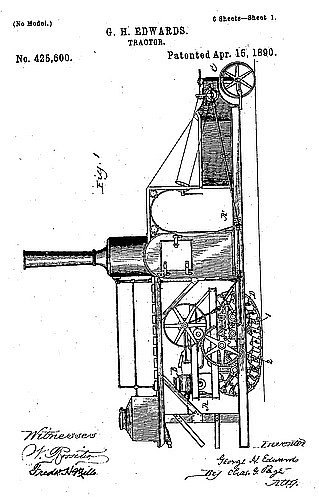In his comprehensive book about building Hart-Parr and Oliver tractors at Charles City, Iowa, John D. Culbertson wrote the following under the heading “1906”:
“One day while writing advertising copy, the sales manager W. H. Williams was struggling with the cumbersome “gasoline traction engine” words when a new word ‘tractor’ flashed into his mind — a word combining ‘traction’ and ‘motor.’ He wrote ‘tractor’ in his copy, and the newly coined name took hold and is alive and well even in the twenty-first century.”
I’ve heard this story ever since I got into the hobby and, at the risk of upsetting Oliver and HartParr enthusiasts, I’m here to tell you that it ain’t necessarily so.
Older than that. Oh, I believe that Williams had probably never heard the word before and truly was convinced that he’d invented it, but no less an authority than the U.S. Patent Office attests to the fact that the word “tractor” was not new at all in 1906. 
As soon as self-propelled vehicles powered by steam became common, men tried to adapt them to agricultural use. The biggest hurdles to steam traction devices in farm use was their weight and poor traction, with the heavy monsters often becoming hopelessly mired in soft fields. Many a brow was furrowed and more than one head was scratched over the problem and many fanciful ideas were the result.
One of the most promising methods of obtaining both traction and flotation on soft ground was to use endless tracks and one of the first patents along these lines was awarded in 1859 to Charles F. Mann of Troy, N.Y., for his “Traction Locomotive Carrying Its Own Railway.”
Other patents for endless tracked “traction engines,” “road locomotives,” and the like, followed through the next four decades, most with little or no success.
Enter George Edwards. A man named George H. Edwards from Lanark, a small town in north-western Illinois, received a patent in 1872 for an “improvement in braced chains,” in which he described a new way of connecting the chain links of an endless track.
George next turns up in 1880, now living in Chicago, with a patent for an improved “tractiontruck,” with an endless crawler-type track. In this patent, Edwards writes: “The object of my invention is to provide a tractor, to be propelled by a steam-engine or other suitable mechanical motor over firm or yielding surfaces, for pulling, pushing, and carrying purposes, as may be required for plowing and other uses.”
Edwards improved that traction truck in 1888 with a further patent in which he doesn’t mention the word “tractor,” but refers to ” … a truck or wagon adapted to carry heavy burdens, and be propelled by a steam-engine or other suitable motor over cultivated fields, swamp lands, or the common highways, for plowing, hauling, and various kinds of work usually performed by animal power.”
Edward’s final patent (as far as I can find) was issued in April of 1890 and is for, of all things, a “Tractor,” a word that was supposedly coined 16 years later by W.H. Williams.
Not a beauty. George Edward’s “tractor” was long and awkward looking, although it had a couple of neat features.
The entire drive mechanism, consisting of two side by side tracks, each on two large rollers, as well as the steam engine, were mounted on a sub-frame that was pivoted to the rear of the main frame in order to allow it to rock and to maintain contact with uneven ground.
The water tank for the boiler was mounted between the tracks and below the engine to keep the center of gravity low for stability on hillsides. The firebox and boiler were mounted on the main frame in front of the tracks and provisions were made for flexible water and steam connections between the two.
Although it doesn’t specify in the patent, the boiler was apparently oil-fired as what looks like a fuel tank is mounted above the rear of the machine with pipes to connect it to the boiler. The driver’s compartment is just ahead of the boiler (warm in winter, but not so great on a hot summer day).
The front steering wheel or wheels appear to be operated by a power steering mechanism, driven by a universal-jointed shaft from the engine and controlled by a lever in the driver’s compartment.
Little else known. I can find nothing at all about George Edward’s life or why he was so interested in tracked vehicles. It would be really interesting to know how he came up with the word “tractor,” and whether the word was used anywhere else during those years.
No further trace of George or his “tractor” can be found, so he probably died a disappointed man.
He should have forgotten about his mechanical inventions and just patented the word “tractor,” and he’d probably be fondly remembered today.
(Send comments or questions to Farm and Dairy, P.O. Box 38, Salem, OH 44460-0038.)
STAY INFORMED. SIGN UP!
Up-to-date agriculture news in your inbox!













i like trains